Bsc Zoology MJC 1 Viral Question Pepper | Bsc 1st Sem Zoology Exam 2024-28 Download PDF
नमस्कार साथियों आप सभी का स्वागत है इस आर्टिकल में इस आर्टिकल में हम आपको जंतु विज्ञान के कुछ क्वेश्चन पेपर देने वाले हैं
जो परीक्षा में आपके छापने वाले हैं इन सभी प्रश्नों का उत्तर आपको अपनी गैस पेपर से जरूर चेक कर लीजिएगा |प्रश्न बिल्कुल रूप से जो प्रश्न यहां से आपको अनुमान लगा कर दिया जाएगा |वही प्रश्न आपके एग्जाम में छपेगा| इसलिए आप लोग इन सभी प्रश्नों को एक बार अच्छी तरह से जरूर देख लीजिएगा| इसके अलावा जो मैराथन वीडियो आने वाला है | उसे वीडियो को भी देखकर परीक्षा में जाए, सभी प्रश्न वहां से ही मिलेगा|

Bsc 1st Sem Zoology Exam 2024-28 Download PDF
साथियों परीक्षा में जाने से पहले दी गई कुछ जानकारी को आप जरूर अच्छी तरह से समझ लें|
आज से शुरू हो रहे LNMU UG 1st सेमेस्टर का परीक्षा में सम्मिलित होने वाले सभी छात्र छात्रों को हार्दिक शुभकामनाएं और बधाई
👉Be Positive 👍😍
👉Best of Luck 🤞ग्रुप एडमिन आपके साथ है
👉परीक्षा हॉल में सकारात्मक मानसिकता के साथ प्रवेश करें और अच्छा प्रदर्शन करें। हमें विश्वास है कि आप अच्छे अंकों के साथ सफल होंगे..
👉कृपया निम्नलिखित बातों का ध्यान रखें:
1.👉 परीक्षा केंद्र पर एक घंटे पहले पहुंचें
2. 👉मूल आधार कार्ड या अन्य आईडी प्रूफ, एक पासपोर्ट साइज फोटो और प्रवेश पत्र लाएं
3. 👉पानी की बोतल और स्टेशनरी जैसे परीक्षा पैड, पेन, पेंसिल, स्केल, आदि ला सकते हैं
4. एक साधारण घड़ी भी ला सकते हैं
5. स्मार्टफोन और चीट शीट (गेस पेपर) परीक्षा केंद्र पर न लाएं, अन्यथा आपको जिम्मेदार माना जाएगा।
6. 👉चूंकि अभी ठंडी का मौसम है, अपने आप को गर्म कपड़े पहनकर परीक्षा केंद्र पर जाएंगे
7. 👉तेज ठंडी से बचने के लिए मफलर, टोपी इत्यादि से अपने सिर और कान को ढक कर रखें….
Bsc 1st Semester Exam Details & PDF Download Links-s
| Exam Date | 16 January |
| Shift Name | 1st Shift |
| Timing | 10; 00 – 1:00 बजे दोपहर तक |
| Join Now | |
| Teligram | Join Now |
| Zoology | Download PDF |
| All Subject | Click Here |
Chemistry MJC/MIC /MDC 1 Download PDF- Click Here
Physics MJC/MIC /MDC Question PDF- Click Here
दोस्तों याद रखिएगा मेजर माइनर और MDC सभी का सिलेबस समान होता है| प्रश्न जो है, मेजर वाले ही आपके MDC में पूछा जाएगा |
100% इसको सही समझिए बिल्कुल रूप से मेजर वाले विषय से ही प्रश्न पूछा जाएगा|


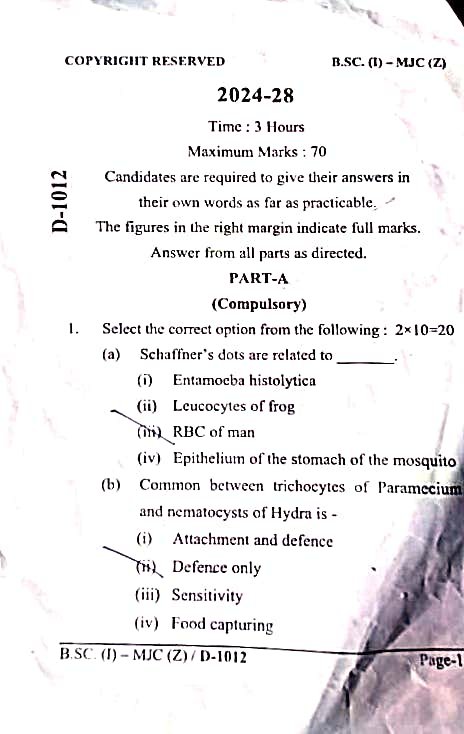
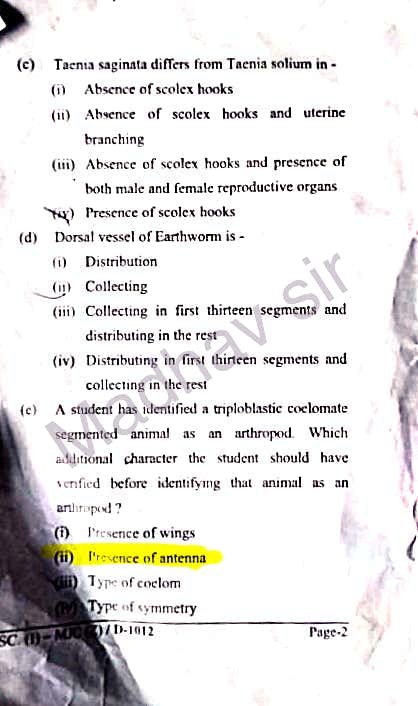
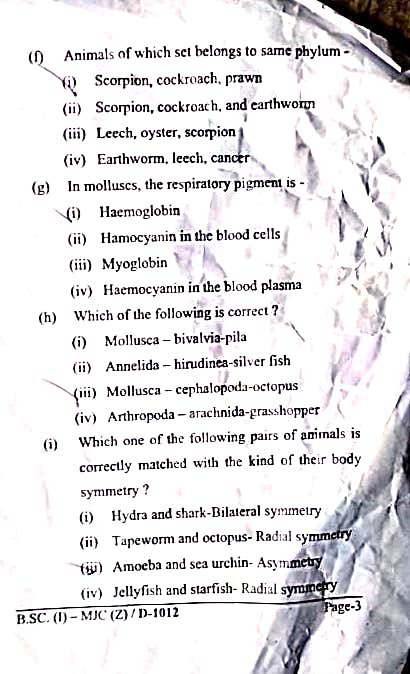
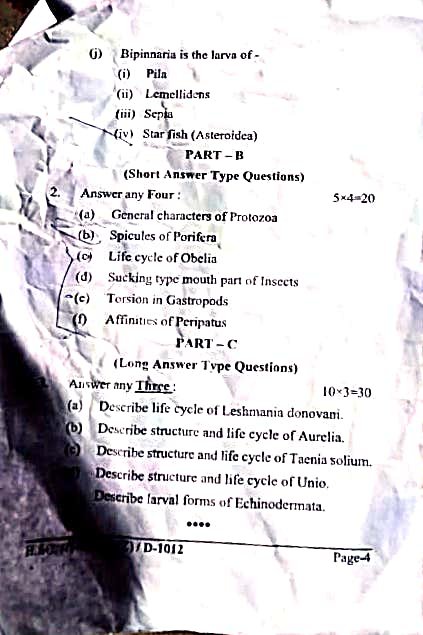
ध्यान रखें मैराथन क्लास को एक बार जरूर देखें
| Obj महा मैराथन | Click Here |
| Subjective महा मैराथन | Click Here |
| Last Q Papper | Click Here |
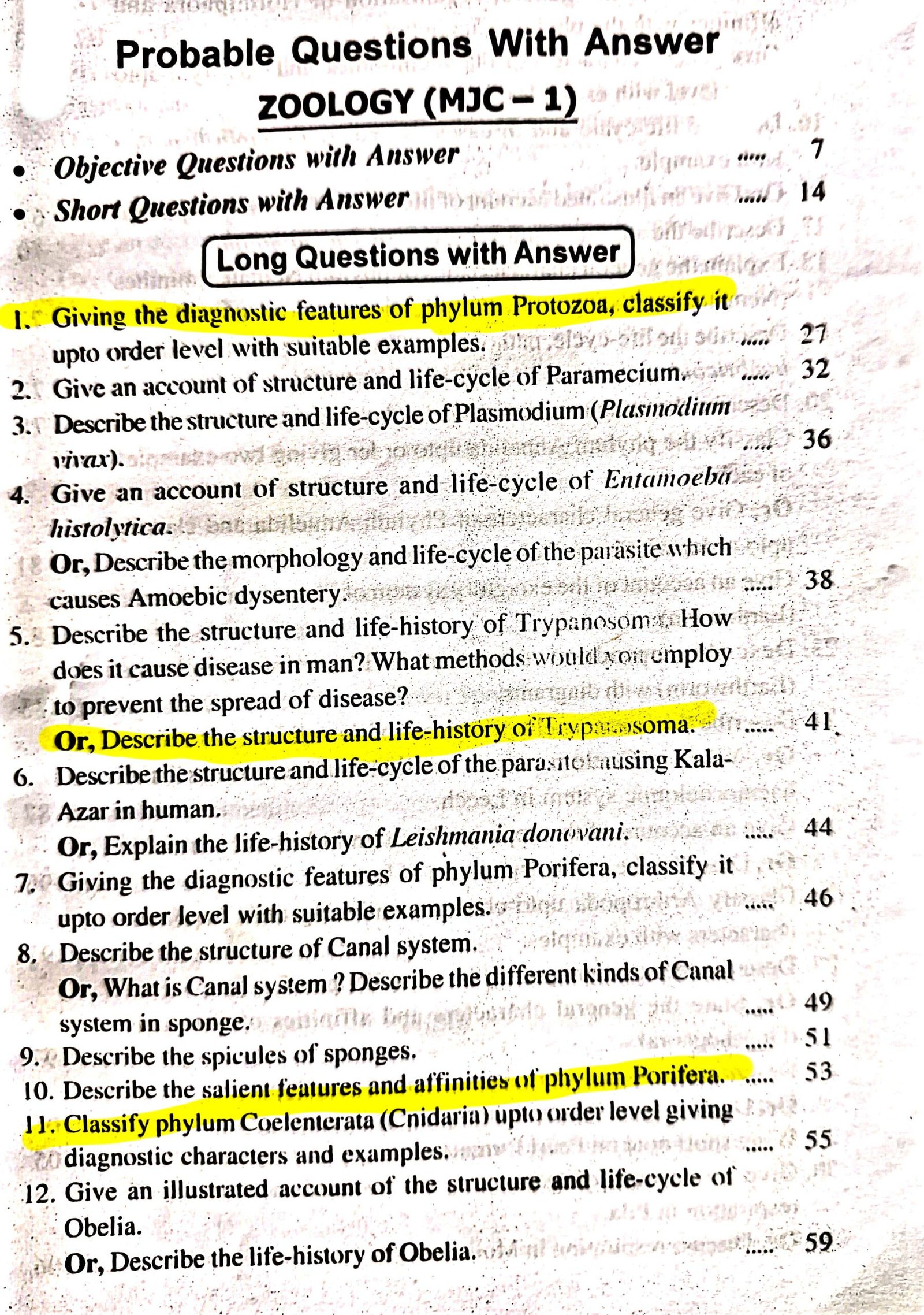
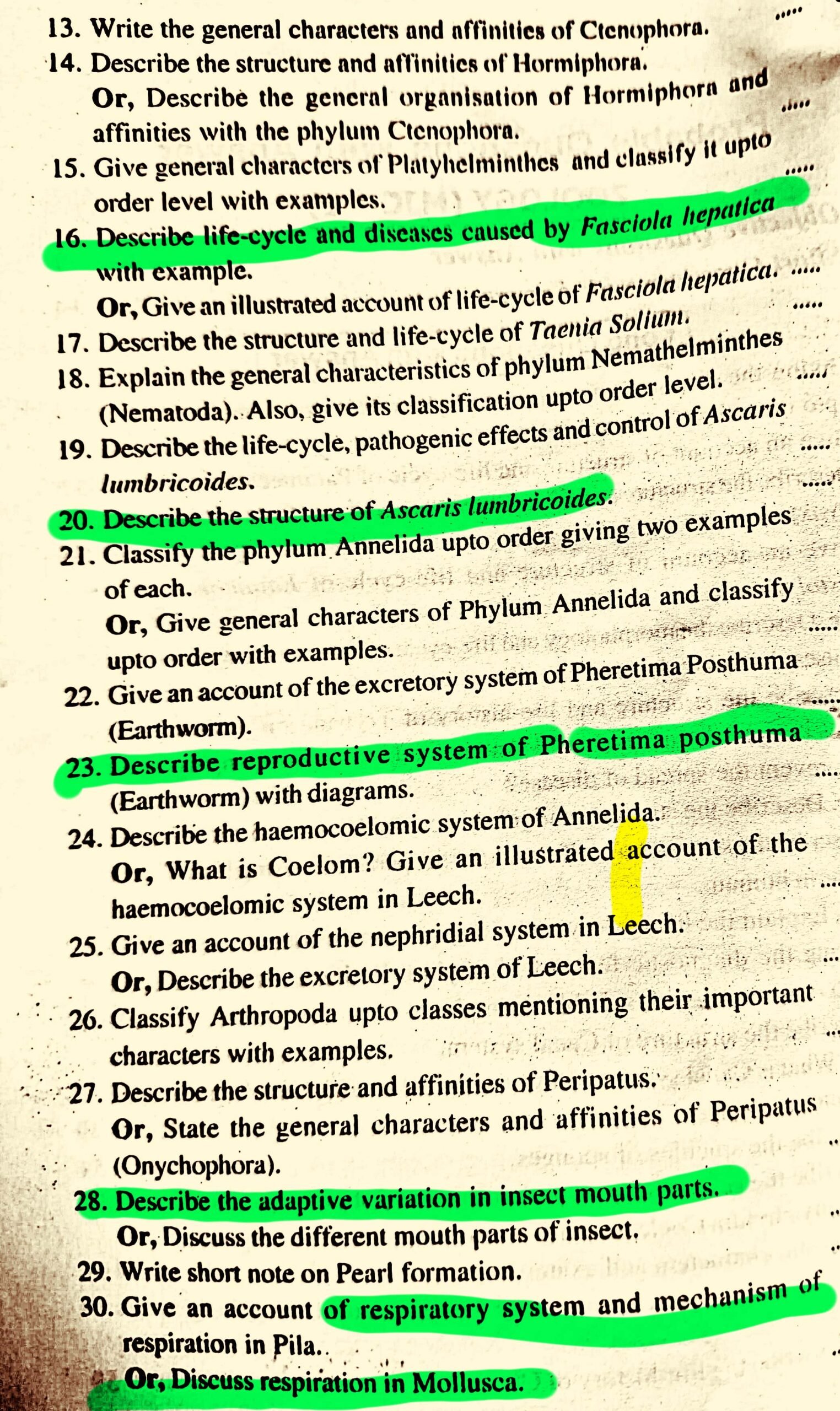
Q.1. Giving the diagnostic features of phylum Protozoa, classify it upto order level with suitable examples.
Ans. The protozoans were first seen by Leeuwenhoek (1676). The name protozoa was given by Goldfuss (1818).
Diagnostic Features: Following are some diagnostic feature of Phylum Protozoa:
(i) Protozoans are the most primitive, aquatic, acellular, microscopic, free swimming or parasitic, colonial or gregarious animalculae.
(ii) Protozoans have protoplasmic grade of body organization. Various functions are performed by organelles,
(iii) Shape of the body is variable.
(iv) Locomotion is performed by pseudopodia, flagella, cilia or suctorial tentacles.
(v) Nutrition is holozoic, saprozoic, holophytic or parasitic.
(vi) Respiration and excretion occurs through general body surface.
(vii) Osmoregulation is done by contractile vacuole.
(viii) Asexual reproduction occurs by binary fission, multiple fission Bok and budding. Sexual reproduction occurs by conjugation or fusion of gametes. Some species show alternation of generations.
Classification: Phylum Protozoa is divided into two subphylum:
Subphylum Plasmodroma
1. Locomotion by pseudopodia or flagella.
2. Only one kind of nucleus.
3. Sexual reproduction by fusion of gametes.
4. Some show alternation of generations
Subphylum Plasmodroma is divided into three classes-
Class 1. Sarcodina benturan vind valasinbergh
(i) Free-living and aquatic.
(ii) Locomotion and ingestion by pseudopodia.
(iii) Cytoplasm is divided into ectoplasm and endoplasm.
(iv) Majority contain one nucleus but some may contain more than one nuclei.
(v) Some animalculae protected by internal or external shell of gelatin, chitin or pseudochitin.
On the basis of difference in structure of pseudopodia, class sarcodina is further subdivided into two subclasses and six orders,
Subclass 2. Rhizopoda
Pseudopodia is without any internal filament.
Q.2. Describe the structure and affinities of Peripatus. Or, State the general characters and affinities of Peripatus (Onychophora).
Ans. General Characters: Following are some general characters of eripatus (Onychophora).
_ 1. Onychophora are specialized for life in the leaf litter and plant debris nd are ideally adapted for squeezing through narrow spaces and cavities mey are found in crevices of rocks, under bark, in stones and in moist places tropical region.
2. They have a worm-like and indistinctly segmented body.
3. Their head is composed of three limb-bearing somites. Thus, head ars three pairs of appendages, i.e., a pair of antennae, a pair of peri-bucca bes hiding jaws and a pair of oral or slime papillae. At the base of each tenna is found a simple eye.
4. Each trunk segment bears a pair of clawed lobopodial ( = lobe-like, mjointed and fleshy) limbs.
5. Body is covered by a thin, flexible and chitinous cuticle.
6. Paired slime or adhesive glands are present, slime is used in food (prey) capturing and self defence.
7. Respiration occurs through unbranched tracheae.
8. Coelom is reduced to gonadal cavities and nephridial sacs. Principal body cavity is haemocoel.
9. Circulatory system includes heart and haemocoelomic sinus like the anthropods.
Q 3. Describe the structure and life-history of Trypanosom How does it cause disease in man? What methods would yon employ to prevent the spread of disease?
Or, Describe the structure and life-history of Trypazosoma.
Ans –Trypanosoma are of the class kinetoplastida, a monophyletic group of unicellular parasitic protozoa. The name is derived from the Greek trypaô (boring) and soma (body) because of their corkscrew-like motion. Trypanosomes infect a variety of hosts and cause the fatal disease, sleeping sickness, in humans.
ट्रिपैनोसोमियासिस <span;>एक परजीवी संक्रमण है जो भूमध्यरेखीय अफ्रीका में त्सेत्से मक्खियों के काटने से फैलता है<span;>। शुरुआती लक्षणों में काटने के आस-पास सूजन, बुखार और मांसपेशियों और जोड़ों में दर्द शामिल हैं। उन्नत लक्षणों के कारण भ्रम और चलने में परेशानी होती है, और जागते रहना मुश्किल हो जाता है।
Q 4.Classify phylum Coelenterata (Cnidaria) upto order level giving diagnostic characters and examples.
Ans The phylum Coelenterata (Cnidaria) is classified into three classes: Hydrozoa, Scyphozoa, and Anthozoa. The class Anthozoa is further divided into the order Anthoathecata.
>Classes
Hydrozoa
• These animals are mostly marine, but some can live in freshwater.
• They are mainly colonial, but some can be solitary.
• The medusa stage is absent in some animals, but present in others.
•
>Scyphozoa
• These animals are all marine.
<span;>• The medusa stage is predominant in this class.
•
Anthozoa
• This class includes sea anemones, corals, and other animals.
Order
• Anthoathecata:
• In this order, the polyps are not enclosed in hydrothecae and the medusae are naked without gonotheca.
Characteristics
• Cnidarians are soft-bodied, stinging animals.
• They are radially symmetrical.
• They have cnidocytes that fire harpoon-like structures to capture prey.
• They have only one opening in their body for ingestion and excretion.
• They are diploblastic, meaning their body cells are arranged in two embryonic layers.
;>फाइलम कोएलेन्टेराटा (सीनीडेरिया) को तीन वर्गों में वर्गीकृत किया गया है: हाइड्रोज़ोआ, स्काइफ़ोज़ोआ और एन्थोज़ोआ । एन्थोज़ोआ वर्ग को आगे एन्थोएथेकाटा क्रम में विभाजित किया गया है।
ये जानवर अधिकतर समुद्री होते हैं, लेकिन कुछ मीठे पानी में भी रह सकते हैं।
वे मुख्यतः औपनिवेशिक होते हैं, लेकिन कुछ एकाकी भी हो सकते हैं।
कुछ प्राणियों में मेडुसा अवस्था अनुपस्थित होती है, लेकिन अन्य में मौजूद होती है।
साइफोजोआ
ये सभी जानवर समुद्री हैं।
इस वर्ग में मेडुसा अवस्था प्रमुख है।
एन्थोज़ोआ
इस वर्ग में समुद्री एनीमोन, कोरल और अन्य जानवर शामिल हैं।
इस क्रम में, पॉलिप्स हाइड्रोथेका में संलग्न नहीं होते हैं और मेडुसा गोनोथेका के बिना नग्न होते हैं।
विशेषताएँ
;निडेरियन नरम शरीर वाले, डंक मारने वाले जानवर हैं।
वे रेडियल रूप से सममित हैं।
इनमें निडोसाइट्स होते हैं जो शिकार को पकड़ने के लिए हार्पून जैसी संरचनाएं बनाते हैं।
उनके शरीर में अंतर्ग्रहण और उत्सर्जन के लिए केवल एक ही छिद्र होता है।
वे डिप्लोब्लास्टिक होते हैं, अर्थात उनकी शरीर कोशिकाएं दो भ्रूणीय परतों में व्यवस्थित होती हैं।










